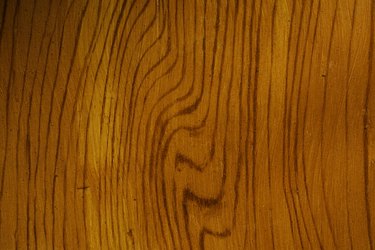Things You'll Need
Brown paint in at least three shades: light, medium and dark
Soft-bristled paintbrush, 2 inches
Stiff-bristled paintbrush, 2 inches
Fine-tip paintbrush for details
Craft knife (optional)

Whether you need faux wood for a doll house, theater set or haunted house, you can paint foam board to suit your needs. The level of realism you attain will depend on your skill with a paintbrush and craft knife, but even a novice artist can cover a piece of foam board with a reasonably realistic wood grain. Pick a type of wood or find an inspiration photo, before buying paint colors and supplies for your project.
Flat Wood Grain
Step 1
Cover the entire surface with your lightest paint color, using a soft-bristled brush.
Video of the Day
Step 2
Run a stiff-bristled brush down the wet paint surface, dragging the bristles through the paint with a free-hand wavy motion to create a fine wood grain appearance. Rinse the brush between each stroke, and make sure all strokes run in the same direction. Let this coat dry completely.
Step 3
Begin to trace over some of the wood grain pattern with a darker paint color, using a fine-tip paintbrush. Again, use a free-hand wavy motion, and allow the stroke to widen and narrow as needed. Make all strokes in the same direction.
Step 4
Dip your soft-bristled brush into the darker brown paint color, and flick the bristles over the surface to soften the edges between the two paint colors. Allow this coat to dry completely.
Step 5
Finish with a light coat of a brown paint that is in between the two shades you've already used. Run the brush quickly over the surface, moving in the same direction as the grain you established. Let the paint dry completely before using the foam board.
Textured Wood Grain
Step 1
Score and groove the surface of the foam board using a hobby knife. Run the knife in a free-hand wavy motion down the foam board, digging deep for some lines and more shallowly for others. Create knotholes by scoring concentric circles in one area.
Step 2
Paint the entire surface of the textured foam board with your darkest paint, making sure you get all the way into each crevice and crack. Allow the paint to dry completely.
Step 3
Dry-brush a stiff-bristled paintbrush covered with the lightest brown paint along the surface, moving perpendicularly to the wood grain to avoid getting the lighter color into the dark crevices. Allow this coat to dry completely.
Step 4
Finish with a light coat of the medium brown paint, running the brush with the grain but avoiding the deep crevices. The resulting piece of foam board should look like a gnarled tree trunk or a weathered plank.
Tip
To give the impression of rotting wood, use black as your base coat.
Video of the Day